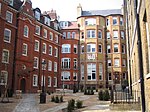Serjeant's Inn

Serjeant's Inn (formerly Serjeants' Inn) was the legal inn of the Serjeants-at-Law in London. Originally there were two separate societies of Serjeants-at-law: the Fleet Street inn dated from 1443 and the Chancery Lane inn dated from 1416. In 1730, the Fleet Street lease was not renewed and the two societies merged. The society's relevance diminished as Serjeants-at-Law were gradually superseded by Queen's Counsel in the nineteenth century. The building in Chancery Lane was sold in 1877 and the assets were distributed amongst the surviving members, although the society was not formally dissolved. The last member, Lord Lindley, died in 1921. (A. M. Sullivan, who died in 1959, was appointed to the equivalent Irish office in 1912, when the English society had effectively dissolved.)The Fleet Street building was destroyed in the 1941 bombing raids during World War II.
Excerpt from the Wikipedia article Serjeant's Inn (License: CC BY-SA 3.0, Authors, Images).Serjeant's Inn
Serjeants Inn, City of London
Geographical coordinates (GPS) Address Nearby Places Show on map
Geographical coordinates (GPS)
| Latitude | Longitude |
|---|---|
| N 51.5137 ° | E -0.109 ° |
Address
Apex Temple Court Hotel
Serjeants Inn 1-2
EC4Y 1AG City of London
England, United Kingdom
Open on Google Maps








